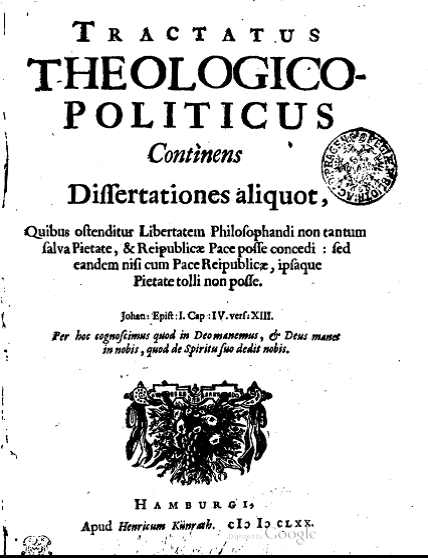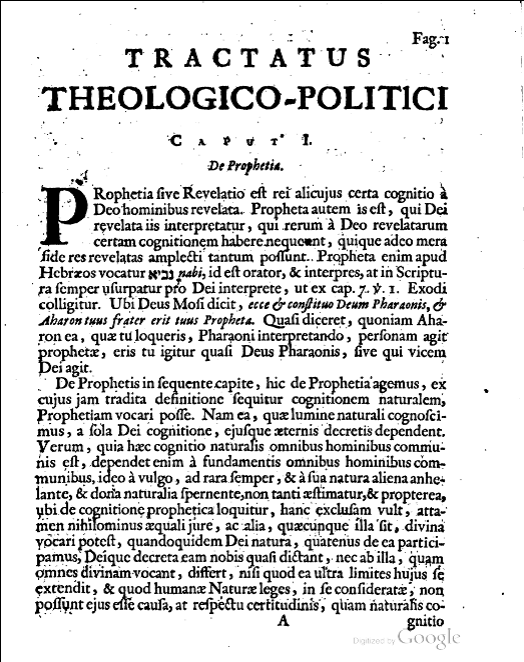- Date
- after 1676
- Collation
- 4to: (*)4 (**)2 A–Z4 Aa–Ff4 Gg2 [$3 (–Gg2), (**) signed as $2]/123 leaves = pp. [12] 1–233 [1]
- Fingerprint
- [> 1676]04 – a1 (*)2 omines$ : a2 (**) is$,$de$ [> 1676]04 – b1 A tu : b2 Gg $N
- Variant
- T.4
- Publisher
- 'Henricus' 'Künrath', alias of Jan Rieuwertsz Sr
- Location
- 'Hamburg' (Amsterdam, ‘in ’t Martelaarsboek’, ‘Dirk van Assensteegh’)
The untimely death of Spinoza on 21 February 1677 and the subsequent publication in the first weeks of 1678 of the Opera posthuma and its Dutch translation De nagelate schriften most certainly revived new interest among readers in the older writings. Since the Hof of Holland had outlawed Tractatus theologico-politicus during July 1674, it may be conjectured that its masked publisher Jan Rieuwertsz Sr evidently saw opportunities to sell off copies of the book to new buyers in the Dutch Republic and abroad. This was also inspired by the fact that perhaps he was running out of octavo copies of the earlier third (octavo) edition (T.3v; T.3h; T.3s; T.3t; T.3e) of the ‘Theological-Political Treatise’. For commercial reasons only, very likely, he launched two new editions (T.4/T.5) of T.1 in quarto in 1677 or later, but he cleverly had its title pages antedated 1670 to conceal the edition and make people believe that the newly laid-up editions preceded the provincial decree of the provincial High Court. That was altogether another ingenious solution to avoid persecution under Socinian legislation that forbade Tractatus theologico-politicus. No historical evidence about the production size or selling price of T.4 and T. 5 has survived.
To all appearances, the books were produced in the same typeface at the Amsterdam Tuinstraat printing office of Israel de Paull, virtually certain on the basis of T.2/T.2a as many similarities in text failures abundantly prove. Why the new editions T.4 and T.5 were not produced on the basis of the far superior older T.1 text or on the octavo edition of Tractatus theologico-politicus is only a matter of pure speculation. Evidently, where T.4 used T.2/T.2a it in turn served itself as the basis for text edition T.5 which provides readers with a much worser text than T.4 presents. There are first of all some interesting common characteristics in T.4 and T.5 that should be noticed here in the first place to demonstrate their inherent correlation. With regard to typography, both editions have on their title pages in line 10 in the Bible section 1 John 4:13 ‘Johan.’ where the earlier quarto editions have ‘Johann.’ Moreover, where T.1, T.2 and T.2a have a publisher’s imprint at the foot of the title page reading ‘Künraht’, T.4 and T.5 have contrariwise ‘Künrath’. This could mean that the title page of T.4 and T.5 was printed for both editions, but of this there is no certainty. Also, on p. 57 note 3 of T.4 and T.5 is keyed with a Maltese cross (✠) where T.1, T.2/T.2a have a double dagger (‡). Finally, the header on page 59 in T.4/T.5 reads ‘V.’ instead of ‘IV.’. In fine, T.4 and T.5 are typographically very closely linked. It should however be pointed out here that the text of both editions was typeset separately.
Annotations
Anonymous, 4to, 4th text ed. of Tractatus theologico-politicus, cover-up place of publication (‘Hamburg’ for Amsterdam), fictitious publisher/printer (‘Henricus Künrath’ for Jan Rieuwertsz Sr), 1676 or later but antedated ‘1670’, probably published after Spinoza’s death on 21 February 1677, new print run with correction of typeset errors based on intermediate source T.2/T.2a
Latin, bold unpointed Hebrew script, occasionally printed Dutch (fraktur typeface, pp. 57 and 159). Latin glosses with occasionally printed Hebrew in external margins (italics, keyed with superior letters), explanatory footnotes, keyed with typographical symbols (italics).
Roman type of the first nine lines of the title page is the reimposed type of T.1. title page: possibly the old T.1 title page was ‘reused’.
Typeset on the basis of T.2/T.2a.
Movable types from the office of the book’s likely printer Israel Abrahamsz de Paull: c.1663/8 ‘Hamburg’ type specimen (some quires of main text, Bartholomeus Voskens foundry), 94 mm ‘Augustyn’ italic (1642 or c.1663/8, Bartholomeus or Reinier Voskens?); 11 mm ‘Paragon’ roman capitals (1652), 16 mm capitals ‘Klein Canon’ roman and italics, ‘Text’ roman and italics as well as probably also Hebrew (2,5 mm mem). For the Voskens typefoundry: Lane, 2004, pp. 50–9, 218–9.
P. 130 misnumbered ‘830’, with reimposed title-page of T.1 (‘Künrath’; ‘1670’). Page 1 typeset ‘Fag. 1’
- Yoke ornament on title-page, woodcut, 35x50 mm;
- No ornamented initials. 20 plain closed black initials (woodcuts);
- Sig. (**)v, tailpiece: reduced version of yoke ornament. The tailpiece was only replaced by a new ornament (flower basket) in the T.5 variant.
References
Graesse, 1859–67, vol. 6, pp. 469–70; Van der Linde, 1871, p. 2, no. 3; Land, 1882b (C); Catalogue, no. 150 (Wolf), pp. 32–3, nos 361–3; Bamberger, 1961, pp. 24–5 (T.4/T.5); Kingma and Offenberg, 1977, p. 10, no. 6.

